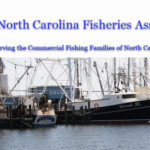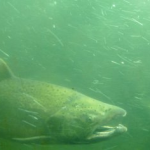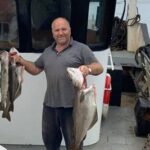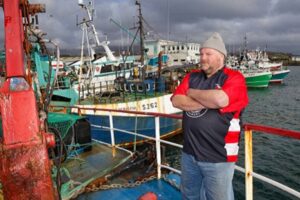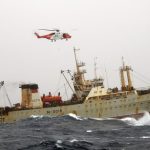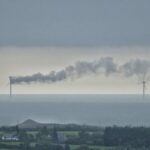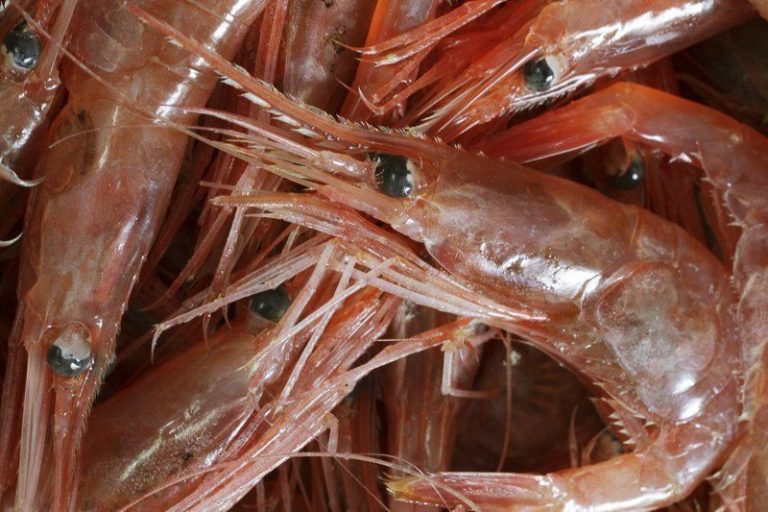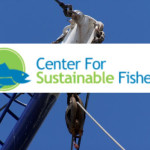Battlefront: Ocean Industrialization
03/23/2014
We can’t win…if we don’t fight!
This is a response (and hopefully an alternative) to the position of “Well, it’s coming anyway, it’s inevitable; so’s we might as well take whatever we can get out of it…go on home, and call it good”
In fact, we probably won’t survive at all…if we don’t fight.
Are we willing to give over our fisheries to the barnstorming energy industrialists looking for a new pair of financial roller skates? Are we willing to let them turn our fishing grounds into oilfields and windfarms, where for “security reasons” they’ll install multi-mile buffer zones preventing any and all craft from entering—except the “officially authorized” of course? Are we willing to let a bunch of Conservation Law Foundation lawyers take over our fisheries management and influence public opinion and cowed officials to regulate fishing into oblivion? These are groups of lawyers that are operating under the false neutral flag of environmental non-governmental organizations, but in reality are working directly or indirectly for mega-industry agenda driven entities such as the Pew oil company money spawned Environmental Defense Fund. These CLF and Natural Resource Defense League lawyers, for instance, are getting rich collecting fees from both ends: from the government when it’s an EPA issue and then of course from whatever beneficent mega-corporation funded eco-group they happen to be representing at the time. They move the scams from one “endangered marine species” to another.
NOAA Fisheries is steered by lawsuits; it’s quite obvious. Pew and CLF lawyers will stand up at a Regional Fisheries Council Meeting and openly threaten the council with a law suit if they dare to consider this or that proposal which might actually not constrict the fishing industry. CLF and company make their living from going to court collecting fees from the NGOs that hire them and again collect fees from the government (that they are suing) when they win the EPA suit. The lawyers are working for big biz, mostly the oil industry through “Foundation” money with many profit-securing directive strings attached.
Are we willing to give over fisheries management to this kind of destructive trickery, the shilling for the minerals hungry energy industry and the choking regulations that result and then presented as what?—as an inevitable consequence of the greedy fishermen overfishing and discarding their by-catch“due to “unfavorable market prices”? Fishing operations are in the way and as citizens and members of the “public trust” are we willing to turn over the precious ocean resource to the perpetrators of Exxon Mobil Valdez, Deepwater Horizon and many, many other oil spill atrocities that have largely been kept out of the complicit media? Are we willing to sacrifice our food producing resources to our increasingly addictive “energy needs”? What about our increasing (clean and edible non-GMO) protein needs?
If you think this is all nothing but “conspiracy theory paranoia”, keep in mind that when a conspiracy is hatched in a corporate board room it is known as an “Upstream Profit Business Plan” and this top floor meeting room thinking is never paranoid but considered ivy-league clever strategizing.
So if it’s not conspiracy paranoia then what is the connection then between the Oil-igarchs and the corrupt and absurdly destructive fisheries “management”? The systematic dismantling of the fishing industry is a crime. If proof is needed of that, just visit one of our nearly empty fishing ports and talk to one of the remaining fishermen. What you will find and hear there is on its face a crime. How would we normally analyze any crime to find the villain? Probably the first question to ask is who is it that would gain from committing a particular crime?
Who would, in this case, gain from getting rid of the US fishing industry on the east and west coasts, Alaska, and the Gulf of Mexico? A fishing industry that might, for instance, be seen as small fleets of whistle blowers bobbing around the oil slicks and constantly calling in reports of leaks and spills, and maybe even bring their own law suits—all very troublesome and undesirable. Who also is having some geo-political difficulty stealing raw (crude) material from countries around the globe as they’ve done for generations? Who needs to “bring it all home” where the “booked reserves” and the drilling is secure and even more profitable? Who has switched the focus form oil to domestic natural gas (in order to tout clean energy) and avoid the extra expenditures for shipping and building gas liquefying factories and infra-structure in foreign lands, countries which might nationalize their resources at any time? And who is on their second “5 year Plan for the OCS”? That is, a plan to exploit the entire U.S. Outer Continental Shelf where there is abundant gas and oil reserves—especially in the North East and especially on Georges. Connect the gooey dots. Not only is the fishing community and our vital national food security at grave risk, but our precious oceans and seashores are about to be turned into an industrial wasteland. This is no time to roll over and play “agreeable compromiser”.
It’s not an option to be compliant and sign up for the handful of jobs maintaining the oil and wind structures—minimal compared to the tens of thousands of jobs lost to a polluted ocean. It’s also not a desirable option (unless there’s no alternative) to elect to accept a onetime buyout at the expense of the entire fishing industry by contributing to the resulting port-destroying consolidation. Those are not options if we care about the ocean and about an industry that supplies thousands of jobs and hundreds of millions of pounds of local, clean, healthy, unadulterated protein.
People around the rest of the world are taking to the streets to stop this kind of injustice; how long are we willing to put up with this kind of resource grabbing corporate greed? Where’s the democracy? Where’s the fight for it? Anyone who cares anything about fishing or about their own general health and the health of their neighbor, or for that matter anyone who cares about the world economy functioning for all the world’s people, has to speak out against this corporate takeover and privatization of everything—of our lives!
I realize that this campaign to eliminate fishing has already cost many fishing families their livelihoods, and we need to speak out and advocate for those people in order to make sure they are made whole and get some actual “relief” from the coveted disaster relief funds. For those still standing though, we owe it to the people who have already lost their ability to fish, to use whatever energy and skills we have to truly “Save the Oceans”. Not from “overfishing”; but from GREED!
Stand up! Speak out! Write comments; make calls; talk to neighbors; talk to friends; go to meetings; send emails or letters. Let uninformed and misled people know what’s going on here—give them a fillet and a message! Show up; don’t stay home and lament! Pull the covers off the reprehensible scams of the “non-profits”.
“Democracy is not what governments do. Democracy is what people do.” Howard Zinn
We can’t win…if we don’t fight!
————————————————————————-
DeepWater Wind and Europol ‘Threat Assessment Italian Organized Crime’
July 5, 2013
Narragansett Town Council
25 Fifth Ave.
Narragansett, RI 02882
RE: DeepWater Wind formed by UPC First Wind
Dear President Callaghan and Members:
There is a new report from Europol ‘Threat Assessment Italian Organized Crime’ that should elevate your concerns about DeepWater Wind formed by UPC First Wind. As I stated to you in my letter of May 8, 2013, (that followed by in person testimony to Narragansett Town Council), in part:
The business history of UPC First Wind affiliates and subsidiaries is remarkable because their wind projects consistently fail to produce energy, yet developers continue to collect public subsidies, from Italy to Hawaii; or their wind projects have been seized by anti-Mafia Police during Operation “Gone With the Wind” as (7) Italian Vento Power Corporation IVPC projects in Italy, with office located at “Via Circumvallazione 108, Avellino.”
————————————————————————————————–
Aloha Fishery Nation,
If Town of Narragansett shoots down cable access it moves up to near Quonset Point however most people are missing the boat with DeepWater Wind and Block Island demonstration offshore wind farm (5 ea 6MW wind turbines) 30MW name plate project.
What most people don’t know is State of Hawaii has been exploring alternate energy since 1960s and at one time had the world’s largest wind turbine in test operations. If it deals with alternate energy it has been tested and documented in Hawaii. HI is an international alternate (green) energy testing center. All except for offshore wind farms which was state-wide rejected as cost prohibitive, damaging to ocean environment and endangerment to marine life, high cost of maintenance, unsightly and artificially driving electric rates higher (they wanted $0.20/Kwh. Purchase Price Agreement (PPA) when burning diesel fuel cost $0.09-$0.11/Kwh.). HI does have wind farms but they are land based also HI has U.S. patents for interfacing wind farms to legacy electrical power grids (grid with no modern smart grid components).
In 2007 President George W. Bush tasked the Department of Energy (DOE) to work with State of HI to lower dependence on imported oil and to become a model of low carbon footprint to rest of the nation. As such State of HI enacted the Hawaii Clean Energy Initiative which requires state-wide reduction of imported oil 70% (40% alternate energy and 30% energy efficiency) by year 2030. Currently of 100% imported oil HI uses 40% to power buildings and 60% for transportation.
HI has a number of firsts in the world, first in the nation alternate energy project demonstrations to commercial production on the record books and is constantly adding to the portfolio. It is awesome living here in HI being on the cutting leading edge of alternate energy independence.
HI is unique in the United States in that 6 of the main 8 islands have their own standalone electrical power grids not inter-connected to each other with a high volume of various alternate energy resources feeding into the individual power grids. Remaining 2 islands one is private and other was used by military for bombing practice and is off-limits to visitors.
According to the DOE no utility power company in the world has completed a test to determine how much fluctuating (non-firm power) alternate energy can be allowed on a legacy electrical power grid before grid destabilization and protective shut down. Currently Hawaiian Electric Company (HECO) allows the industry de-facto standard of 15% alternate energy on a legacy grid before expensive additional safeguards are required to be implemented.
2012 State of HI, University of Hawaii, Natural Energy Laboratory of Hawaii Authority (NELHA), HECO, DOE, and two foreign countries and scientists formed a signed partnership to utilize State of HI power grids real-time under normal loads to; a) fully test and document over the next two years how much fluctuating (non-firm power) alternate energy can be allowed on a legacy electrical power grid before grid destabilization and protective shut down, b) Fully test and document over the next two years electric grid smart grid components and life-cycle, c) Fully test and document over the next two years electric grid smart grid components security requirements; d) Fully test and document over the next two years how electric grid smart grid components change a legacy power grid and e) fully test and document over the next two years how much fluctuating (non-firm power) alternate energy can be allowed on a smart grid electrical power grid before grid destabilization and protective shut down. Testing should be completed around 2015 or 2016 with international published results.
Some points about Block Island, Block Island Power Co. (BIPCo), DeepWater Wind and electric power:
1. BIPCo has a legislative charter to be the exclusive distributor of electricity on Block Island and supplies the electricity by operating diesel generators.
2. Wednesday, January 28th, 1998, The E.P.A. and the U.S. Department of Justice announced that they have settled a civil case with the BIPCo regarding the utility’s violations of the Clean Air Act that began in 1981. BIPCo must install nitrogen oxides (NOx) scrubber on all and illegally installed diesel generators or install an undersea power cable from mainland (RI) power utility company and remove diesel generators plus pay a $90,000 fine.
3. A National Renewable Energy Laboratory “A Preliminary Analysis of Block Island Power Company’s Use of Clean Distributed Resources to Provide Power to Its Customers” Technical Report was completed August 1998: http://www.nrel.gov/docs/
4. BIPCo opts to install nitrogen oxides (NOx) scrubber on all and illegally installed diesel generators at a cost of approximately $42 million verses approximately $40-$47 million to have undersea power cable installed. This thought to or estimated to effectively protect investor rates of returns. If BICo had installed a cable then it would have to try and recoup the cable cost from Block Island only residents after it had just purchased new diesel generators and there are hints of problems with current underground diesel fuel storage tanks.
5. BIPCo operates a legacy power grid designed to be powered by firm-fixed diesel generators providing fixed voltage, fixed ampacity and fixed frequency (Hz). Maximum peak power demand is approximately 11MW. It is neither cost effective nor prudent catastrophic maintenance wise to operate diesel generators at 50% or lower of rated power demand.
6. DeepWater Water offshore wind power turbines provide constantly fluctuating (non-firm power) alternate energy power voltage, ampacity and frequency (Hz) due to constant changes in wind direction and speed.
7. DeepWater Wind indicates in statements they can power Block Island up to 90% of power needs and allow National Grid to supply 10% of power via undersea cable and sell excess power to National Grid from wind farm (Jeffrey Grybowski, CEO of Deepwater Wind is blowing smoke in everyone’s ears because he doesn’t know as it has not been tested nor accomplished on a small island scale).
8. A review “Study on maximum permissible intermittent electricity generators in an electricity supply network based on grid stability power quality criteria” by Michael Knopp dated January 10. 2012 study about adding wind farm to St. Vincent Island 2013: http://www.credp.org/Data/MT-
indicates between 20% and 40% allowable maximum intermittent power on the small island diesel power legacy electric grid before grid instability.
9. By adding the bidirectional power cable from National Grid allows DeepWater Wind to mask the amount of power being supplied to Block Island from offshore wind turbines and percentage required trying to stabilize the grid before grid trip out by National Grid plus pass the cost of the undersea cable on to all RI ratepayers except Block Island ratepayers who will see a reduction of rates by 40% while everyone else electric rates rise.
10. DeepWater Wind is proposing to use Siemen’s new untested new design and new technology 6MW direct-drive large offshore wind turbines for the Block Island demonstration project. Three blade balanced turbines require very expensive special ocean-going jack-up barges for installation and maintenance.
11. Underwater supporting structures for the wind turbine farm have never been constructed or tested for New England area North Atlantic Ocean.
12. DeepWater Wind has never completed or built a project.
13. DeepWater Wind exhibits total disregard for human safety by design to run 35KV power lines 10 ft. under the beach sand at pristine Narragansett Town Beach where children play, dig in the sand and the unknown interface requirements to the power grid and cable run near or through Little League ballpark, family park and wetlands.
14. DeepWater Wind has not indicated many barrels of oil and lubricant must be supplied and stored to each wind turbine in the water and if an offshore electrical transformer platform will be required that possibly would be oil filled for cooling. Storage of so much oil could pose an ecological problem for the pristine waters of RI and Narragansett Bay marine life in case of an accidental spill, hurricane or tropical storm damage.
15. First Wind which is a company partner of DeepWater hooked up the last grid power interface for a HI ground based wind farm which suffered three fires, last one of which burned for three days releasing toxic materials (lead) into air and burned the steel interface building to the ground and destroyed storage units effectively taking the wind farm totally off-line.
16. DeepWater Wind is installing nameplate 30MW of which 40% maximum (12MW) will provide constant power to Block Island. Block Island peak power usage average is 11MW. 30% average usable intermittent wind power to Block Island without causing legacy grid instability would be 3.3MW of wind power usable on the Block Island legacy power grid leaving 9.7MW being sold to National Grid’s trunk grid. In return, National Grid would need to provide 8.7MW firm-fixed conditioned (baseload) power via bidirectional cable to Block Island so diesel generators could be shut down, diesel tanks drained and removed and diesel generators sold as second-hand.
17. Block Island residents will see a 40% rate reduction and rest of state of Rhode Island resident ratepayers would see increase in rates (up to $0.46/Kwh) paying approximately $415 million to $430 million surcharge for the 30MW demonstration offshore wind farm over next 20 years that will only be supplying an estimated maximum 3.3MW (unless the legacy grid is fully upgraded to smart grid at extra cost) to Block Island however, Block Island residents will get a free mainland (RI) power cable installed, cheaper electric rates, less air pollution and more dependable electric service through BIPCo and National Grid.
18. One has to answer the question; “Does having the mainland (RI) state population pay approximately $415 million to $430 million surcharge and additional unspecified charges and operating costs plus creating 6 full time jobs over the next 20 years for an estimated 3.3MW (2ea-6MW wind turbines at 28% power) of clean alternate energy for approximately 1,000 residents a good fit and economic sense for RI?
19. One also must ask; “Is the demonstration offshore wind farm really necessary when it will be only supplying estimated 30% power (limited by legacy grid stability) and mainland (RI) cable is supplying 70% firm-fixed (baseload) power?”
Hope this has provides some insight!
Am so I happy I moved out of RI!!!! The electric rates will be highest in the nation in RI; higher than in HI if DeepWater Wind ever completes this project and finally gets it operational within safety standards!
See attached Email sent to Narragansett Town Council.
Aloha,
Ken Williamson
See attached Email sent to Narragansett Town Council here
Subject: Ocean Policy
————————————————————————————————————————-
M. Ben-Yami Column WORLD FISHING, MARCH 2013
BLOWING IN THE WIND
The American commercial fisheries seem to find themselves in a sort of a siege. According to voices coming from the affected fishermen and the local press serving fishing ports and communities, on the top of being plagued for the last four years by the adverse catch-share system, they had been hurt by the mega-spill of oil in the Mexican Bay, severely injured by the recent hurricane Sandy and struggled, evidently in vain, for obtaining their share in the related federal damages.
The way the wind blows. Recently, the East Coast fishermen have been alarmed by a new threat hanging over their heads: the plans of constructing a gargantuan network of offshore wind-power farms that would be stepping hard on their fishing tows. For example, in Southern New England off Connecticut, Rhode Island, Massachusetts, and Long Island, two hundred 150-180-m tall wind turbines are supposed to be erected on lease sites overlapping the spawning and fishing grounds of loligo squid and other species, including, e.g., yellowtail flounder.
The proposed lease area offshore Rhode Island and Massachusetts covers approximately 164,750 acres (666.7 sq. km) and is located about 9.2 nautical miles (17 km) south of the Rhode Island coastline. The area will be auctioned as two leases, referred to as the North Zone and South Zone. The North Zone lease will consist of about 97,500 acres,
(394.7 sq.km), and has the capacity to support more than 1,000 MW of wind generation. The South Zone lease will consist of about 67,250 acres (272.1 sq.km), and is capable of supporting a project of between 350 – 1,000 MW. Together, these zones could support enough electricity to power 700,000 homes.
Ill winds. It seems that the industry is facing a hard uphill struggle against the marine fraction of the national campaign for clean energy advancing under the umbrella of Bureau of Ocean Energy Management (BOEM). All the more that the planned development seems attractive to several other direct and secondary shareholders. For example, according to New Bedford Standard Times, John Mitchell, the mayor New Bedford, which is one of the main American fishing ports, views offshore wind turbines as a development opportunity not for just the Cape Wind project but also as generating a much larger development of an industry all along the New England’s coast of which New Bedford is the industrial center. “Our goal ultimately is to maximize job opportunities for folks living in the city of New Bedford” he said. When one looks on the investments scope, with a quoted price of just one wind turbine ranging from US$ 2mn to 4mn plus installation costs offshore, the initial investment in the installation of the 200 planned turbines will probably cross the 1/2 billion of US$. With the consequent maintenance and other services added no wonder that some leaders would weigh the potential benefits to their communities against the existing, hard pressed and consequently shrinking local fisheries. For the coastal fisheries it may be an ill wind that blows nobody good…
There goes a buzz among the East Coast fishermen that BOEM is too close to corporations associated with the wind/oil/gas/minerals business. They also looking with a wary eye on the contractor that is going to lay the underwater power line leading from the offshore wind farms to the consumer centres of “Big Dig” (a major tunnel project), the Bechtel group. This, because this group, according to the Department of Justice and the Massachusetts Attorney General, hasagreedto pay along with its subcontractors $407 millions to resolve its criminal and civil liabilities in connection with the collapse of part of the I-90 Connector Tunnel ceiling and other defects in the Tip O’Neil tunnel, other construction deficiencies and false reporting.
Cape Wind. In the meantime both the federal and the state authorities, after several years of negotiations and litigations, have approved the Cape Code wind farm at Nantucket Sound, on the Horseshoe Shoal, the construction of which is set up to start this year. The proposed project covers 24 sq. miles (62 km2) and envisions 130 wind turbines, each having a hub height of 285 feet (87 m). The blade diameter is 364 feet (111 m), with the lowest blade tip height at 75 feet (23 m) and the top blade tip height at 440 feet (130 m). The turbines would be sited between 4–11 miles (6.44-17.71 km) offshore depending on the shoreline. At peak generation, Cape Wind is expected to produce an average of 170 MW of electricity, about 75% of the average electricity demand for Cape Cod, Martha’s Vineyard and Nantucket island combined.
Currently 45% of the Cape region’s electricity comes from the nearby Canal Generating Plant in Sandwich, which burns bunker oil and natural gas. According to an optimistic estimate, Cape Wind could offset close to a million tons of CO2 every year and its electricity production would reduce the annual consumption of fuel oil by 430,000 m3.
However, Nantucket Sound constitutes essential fish habitat for many important species of finfish and invertebrates, including bluefish, striped bass, scup, summer flounder, black sea bass, and squid. Their commercial and recreational harvest adds millions of dollars to the local economy. Horseshoe Shoal, which comprises spawning and nursery grounds, as well as abundant hunting grounds for piscivores and a target area for commercial and recreational fishermen, is the most prominent ecological bottom feature in the Sound.
Problems. Not that the wind-power industry doesn’t have its problems. As a fishery activist Barbara Durkin reported: Cape Wind represents an unreliable energy source as turbines manufactured by GE AND Siemens and projected also for Cape Wind are “discontinued”, “sinking”, shifting” and “corroding”. It appears that in many Dutch, Danish and German wind farms faults in the Europe-wide design standards have been identified, and towers are shifting several centimeters under the impact of harsh offshore conditions. According to Angela Jameson, writing in Times Online, hundreds of offshore “monopile” wind turbines could be suffering from a design flaw that makes them sink into the sea.
Gone with the wind? Another setback is, according to Sunday Times, the failure of wind farms to generate enough electricity even in windy conditions when many turbines were forced to shut down in winds of 56 knots, with power from wind turbines slumping by 2/3in hurricane-force winds. On the other hand, in 2010, lack of wind caused most of Britain’s turbines to stop producing.
Rhode Island Coastal Resources February 1, 2013
Management Council
Oliver H. Stedman Government Center
4808 Tower Hill Road
Wakefield, RI 02879
Re: Objection to Deepwater Wind Requested Waiver of Application Fee
Dear Sir/Madam,
Please be advised that I respectfully request that my objection to Deepwater Wind’s request for waiver of application fee be recorded and be a matter of record in this matter. In addition to objecting to Deepwater’s requested waiver, I am also requesting that a public hearing be scheduled in order that the public be afforded the opportunity to be heard and to witness the process as CRMC considers Deepwater’s request.
In September of 2012, Deepwater filed an application with CRMC seeking a Category B Assent relating to its proposed construction of an offshore wind farm located approximately three miles southeast of Block Island. The application specifically relates to the installation of a transmission cable in State waters. Traditionally, the fees attended for such application must be paid prior to the issuance of any assent by the Council. The required fees in question here total approximately $750,000. Deepwater elected not to render payment of fees upon submission of its application and has requested a credit for funds it alleges it contributed to a fund managed by the RI Economic Development Corporation.
Significantly, Deepwater is not a public or quasi public entity, eligible for a waiver of filing fees by CRMC. Deepwater and its investors stand to earn an incredibly handsome return from their proposed project. Such return is partially due to the fact that National Grid will be compelled to pay 24.4 cents per kilowatt hour for power generated by the Deepwater project. Remain mindful that currently consumers pay about 7 cents per kilowatt hour. Coupling the aforementioned factor, with investment tax credits totaling approximately $55,000,000, which Deepwater stands to gain, it is abundantly clear that this is not simply a public works project designed to serve the consumers’ interests.
CRMC has been placed in a uniquely awkward position as the “Joint Development Agreement” of January 2, 2009, initiated by the Economic Development Corporation and the Office of the Governor, designated Deepwater as a “preferred developer”. Essentially, the State handpicked the developer and through the JDA is postured to positively influence any outcome of the proposed project. It is arguable that the CRMC, being an agency of the Government of the State of Rhode Island, is equally obligated, under the JDA, to influence any outcome relative to the Deepwater project. While I have the utmost respect for the integrity of the Executive Director and staff as well as the Council itself, this is certainly a situation which presents “cause to pause”. It appears the Council is being used to justify a preordained result. The credibility of CRMC is of paramount concern.
One must question how CRMC can accept and process Deepwater’s incomplete application, in violation of its own regulations. Transparency in Government is essential. If a Government agency, such as CRMC intends to entertain the request of a private developer to have $700,000 in application fees waived, the public has a right to know and hear arguments pertaining to same.
Respectfully submitted,
James E. O’Neil, Esq.
Former Attorney General,
State of Rhode Island
U.S. Army Corps of Engineers February 1, 2013
New England District
Attention: Michael Elliot
696 Virginia Road
Concord, MA 01742-2751
Re: Deepwater Wind
File Number NAE-2009-789
Dear Mr. Elliot,
I am respectfully requesting that the Corps comply with the National Environmental Policy Act (NEPA) and applicable Federal regulations by compiling an objective, independent environmental impact statement relating to the Deepwater application. Deepwater’s proposed project will consist of five wind turbines, measuring approximately 660 feet in height, covering 117 acres of ocean located three and a half miles, south, southeast of Block Island, Rhode Island. Dredging which will be essential to the project as well as the obstruction of navigation will be significant. The recent concern regarding the decrease in Winter Flounder and the impact the Deepwater project will have on that precious population is clearly an issue. Some have argued that the turbine structures will create a reef which will attract a greater population of fish. If in fact such premise has a ring of truth, one must then wonder how can the hard working members of our fishing fleet harvest fish in waters being “beaten” by turbines. This is not simply a public works project; this is a project by a private developer who stands to earn millions.
As I am certain you agree, transparency in Government is essential to gaining the public’s confidence in Government. The State of Rhode Island’s Economic Development Corporation, joined by the preferred developer, Deepwater, commissioned the Special Area Management Plan, (SAMP) apparently, in an effort to develop an environmental impact statement concerning Deepwater’s proposal. It is my understanding that under the Joint Development Act entered into by the State with Deepwater, CRMS is required to adopt the SAMP findings and to use such findings to support the acquisition of Federal permits and approvals. I certainly do not question the fact that many dedicated scientists have put great effort into SAMP. However, the fact that Deepwater and the Economic Development Corporation commissioned SAMP, presents a conflict of interest as the vendor, Deepwater, has had a role in funding and selecting the very entity which is designed to evaluate its proposal. NEPA requires an EIS that is absolutely objective and devoid of any appearance of conflict.
Recognizing that the Deepwater project will significantly affect the quality of our environment and NEPA commands the Corps to offer an explanation to the public concerning the environmental issues which have been analyzed it is clear that the Corps should properly commission an independent, objective environmental assessment of the Deepwater project. The “harm” of concern in NEPA situations is not simply the harm to the environment, but the “harm” incurred due to the failure of decision makers to take environmental factors into account in the manner in which NEPA mandates [emphasis added]. NEPA requires the Corps to do more than simply rely upon environmental analysis commissioned by the applicant.
Therefore, based upon the aforementioned reasoning, it is respectfully submitted that the Corps has the obligation to conduct an independent, unbiased assessment of the impact of the Deepwater project upon our environment.
Respectfully Submitted,
James E. O’Neil, Esquire
Former Attorney General,
State of Rhode Island
February 4, 2013
———————-
Mr. Daniel Goulet
Office of Customer and Technical Assistance
R.I. Coastal Resource Management Council
Stedman Government Center, Suite 116,
4808 Tower Hill Road,
Wakefield, RI 02879-1900
[email protected]; council@
Re: PROTEST and REQUEST FOR PUBLIC HEARING
· Deepwater Wind Application for Permitting BITS; and
· Deepwater Wind Application for Permitting BIWF
Dear Mr. Goulet,
The undersigned objects to the above-referenced applications for issuance of a Category B Assent, and requests that public hearings be held regarding each of these separate projects.
The applications relate to a major project and development that does not meet the standards established under section 1160.1.1 of CRMC’s Ocean Special Area Management Plan (OSAMP). The burdens of proof on the applicant have not been met by the Environmental Report it has submitted, which fails to fully analyze all cumulative impacts, or assess reasonable alternatives that would cause less harm to the environment.
The undersigned requests that one or more public hearings be convened with respect to such applications. One such hearing should be convened in the affected community of New Shoreham, and another in the affected community of Narragansett. The undersigned also respectfully requests that CRMC recommend to the Army Corps of Engineers that it conduct a full Environmental Impact Statement before taking any permitting action on this project.
Public safety is at risk under the proposal with respect to where and how the Project’s dangerous high-voltage transmission cables connect to the mainland and Block Island. Plans call for the cables to cross beaches used by the public. One alternative under consideration would involve a burial depth of as little as four feet
(see: Environmental Report Section 3.3.3), which would pose a high hazard to beach users. Another alternative would require the high-voltage cable to be buried 12 feet below the surface, and this approach would appear to present less risk to the safety of beach users. The potential public safety impacts posed by the Project have not been adequately addressed in the Environmental Report.
The proposed dredging activities will have severe adverse impacts on fish, including potential long-term impacts to winter flounder and other species of concern. The proposed dredging methods also present unacceptable long-term risks to lobsters and other marine life, and these adverse impacts have notbeen sufficiently researched and analyzed. The impact of artificial lighting on recreational fishing, particularly the economic impact of the potential loss of a season of striped bass fishing has not been demonstrated as limited nor short term.
The proposed installation, construction, and siting of the BIWF project will have a severe adverse impact on the migration of a Federally endangered species, the North Atlantic right whales. Applicant negotiations with NGO’s who favor the BIWF project do not constitute an adequate analysis and review of the harm to be caused these mammals. The Northern right whale is the rarest of all large whales, enjoying not only Federal endangered species protection but global international protection as well. Right whales make frequent calls to each other over distances of 20 miles or more. According to the applicant’s ER, “During operations, it is likely that the Wind Turbine Generators will produce low-level continuous underwater sound”. The impact of pile driving during construction and the adverse impacts of locating the BIWF project at NOAA’s Block Island Seasonal Management Area have not been sufficiently researched and analyzed. The location and sound will be a permanent obstruction in an area designated as part of the migratory route and calving grounds of the endangered whales. The area has Federal restrictions from November 1 through April 30 every year with insufficient research and insufficient evidence of no significant impact on this endangered, on the edge of extinction, species.
I oppose the applicant’s plans to abandon and leave in place the cable that will connect the BIWF to Block Island at the end of its useful life of 20 years, which would amount to leaving tons of solid waste buried in the marine environment. This plan is completely unacceptable, and the requested permits should be denied on that basis alone. In addition, the applicant has grossly underestimated the adverse impacts associated with the Project by not describing the impacts associated with the removal of the buried cable after its useful life. Alternatives to leaving the cable as litter on the ocean floor (such as recycling the metal in the cable) are required to be discussed andanalyzed, but the applicant has failed to do so in the incomplete Environmental Report, and application. CRMC should require a surety bond that would be sufficient to cover the projected cost of removal of the cables from Rhode Island’s submerged lands.
The Application Overstates and Misidentifies the Purported Environmental Benefits of the Projects
Deepwater’s Environmental Report asserts that the project will result in air quality improvements, but when scrutinized the claim is overstated. The Environmental Report claims “the 124,500MWh/yr. projected to be provided by this Project would displace at least 58,000 tons of CO2 emissions from BIPCO and the mainland.” (4-32). CRMC must reject this claim since the ER notes that the Project “is unlikely to displace base load generation from coal-fired power plants,” and instead will displace generation from natural gas fired power plants. (Id.). Deepwater’s claim is based on the assertion in the ER that the Project could displace the diesel-fired generators that are currently used to power the Island, and their associated air emissions. This claim is unfounded and overstates the purported air quality benefits of the project. Nothing in law or contract requires the Block Island Power Company to abandon its diesel generator power-producing capabilities if theProject is constructed. The BIPCO diesel generators will not be retired, but will instead be used to ship power to the same regional energy grid that will be used by the applicant. Thus, while distant urban centers will reap any energy supply benefits, Block Island and the state will never achieve the promised overall reduction in air quality emissions from the addition of the BIWF. The economics associated with BIPCO’s right to burn diesel fuel on Block Island in order to supply power to out-of-state consumers eliminates the “air quality” benefits being touted by Deepwater.
Thank you for your consideration of my comments and objections to the subject application. Please notify me of the date and time of the public hearings.
The enemy is government in partnership with industry cooking science and posing threats to our food source, ecology, economic engine, our use rights, and public safety. Barbara Durkin
Going after government with partisan anger and bitterness is exactly what big oil company strategists want; it keeps us from noticing the reprehensible natural resource-grabbing scams they try to pass off as ecologically sound business plans. It’s kind of like the drunk bumping into you on the subway, while his partner picks your pocket completely unnoticed in the distraction and confusion.
This is why I believe that and how I think it works:
Oil companies’ stock values are dependent on profit margins or “Return On Capital Employed”, but even more important, a company’s contracted oil reserves are the basis for healthy stock share prices.
From Private Empire: Exxon Mobil and American Power by Steve Coll
The business models of the major international oil companies such as Exxon, Chevron, Royal Dutch Shell, and British Petroleum—and the prices that their shares commanded on Wall Street and on the London exchange—depended in part on the size of the underlying trove of oil and gas the corporations could claim to own. “Booked reserves” or “equity oil” referred to those proven reserves that a corporation controlled legally and could exploit for sale in future years.
Exxon and its peers could display such equity reserves to shareholders as “proved” or “booked” oil under regulatory and accounting rules enforced in the United States by the Securities and Exchange Commission. The size of these booked reserves allowed shareholders to estimate future profits with relatively high confidence; equity oil was fundamental to Exxon’s stock market valuation, just as the number of shopping malls or office buildings owned by a real estate company would be fundamental to its market value.
So if an oil company pumped and sold one million barrels of oil in a year it would have to show Wall Street that it can replace at least that amount from its owned reserves or potential oil in the ground—in fact it might have to document a few years of reserve supply.
From Private Empire If an oil company failed to replace production for a sustained period, it would be on a path to liquidation. Under U.S. Securities and Exchange Commission—supervised accounting rules, the oil and gas reserves Exxon and its peers reported to shareholders were not carried on corporate balance sheets, but they were reported each year in S.E.C. filings. The reserves were among the most important assets oil companies described to investors because they suggested the scope of a particular company’s potential future profits and its sustainability. The sheer size of a company like Exxon or Shell increasingly made the math of annual reserve replacement daunting—more than a billion barrels had to be found and booked as new equity reserves each year if the company did not want to appear to be shrinking.
The oil companies manipulate this standard in several ways including outright lying or claiming “tar sands” oil as reserves, (since there is a great deal more expense involved in mining the tar sands) this is a dishonest presentation of reserve profits.
It’s also clear that the quest for reserves to balance off our 3rd largest-in-the-world production and our world leading domestic consumption has a lot to do with our power-presence in the riskier oil rich areas of the world. But closer to home for the fishing industry, the frantic and compulsive need to secure future safe domestic reserves in order to buoy oil company stock prices is essential to understanding this mindless, frantic, and compulsive drive to remove fishing and “Wind Baby Wind” so’s we can “Drill Baby Drill”.
These stock price dependent oil reserves, upon which Wall Street oil fortunes hang, happen to be right under our prime fishing grounds. But as the pretty lady in the latest blitz of TV oil ad propaganda implies, “…don’t mess with oil; many of your piddling retirement account funds are invested to the hilt in oil”. Oh yes, “and oil employs three million people” (probably half of them work in Washington, D.C).
The corporate backed “NGO’S” are literally writing legislation for congress to ram through—while we look the other way, busily trying to change governments. They say “…sure go ahead and replace this or that administration; take your pick, it doesn’t matter, money talks and nobody walks; we’ll just buy our way into that one as well”. They’re not prejudiced—any political orientation, any administration will do. Money is a universal solvent.
Big business doesn’t really care about political parties or their philosophies; they’ll buy from either side, whoever’s for sale. Their only concern is profit and how they can wield influence most effectively. They care about manipulating public opinion and public officials any way they can to get the policies through that are favorable to their particular businesses’ future profits.
Going after government or one party or another is a grand distraction that big business loves; they can then do whatever they like behind the scenes. Once rigidly locked into any political dogma, facts, truth, reality, often become obscured, casualties lost in the bickering—and that’s the oil-igarch’s strategy.
Government is responsive to money or the greatest number of votes and voices. Fishermen have no money so massive awareness and activism is the only thing that will counter the billions being spent in Washington by corporate lobbyists. Money buys the influence that keeps the corporations in power and working people in desperate straits.
Why fishermen are not speaking up more about these “wind farms” as they backdoor oil and gas drilling is a mystery. Not paying attention to such real everyday threats is what makes our entire way of life most vulnerable. It’s the way big oil is able to get away with some very real threats to the environment while claiming the ecological high ground: “clean safe gas” (fracking), (out-of-sight/out-of-mind) offshore deviated drilling, “carbon sequestration”, wind farms, etc. It’s oil for the most part that’s causing massive pollution. And it’s oil propaganda through the NGO puppets that has accomplished a complete role-reversal and made fishermen out to be the “perp’s” in all this.
The oil companies need the outer continental shelf’s oil reserves to point to for their S.E.C. filings which bolster their stock value. The outer continental shelf is close by, protected by U.S, Coast Guard and Navy, and aside from some pesky “little people” fishermen, it’s up for grabs. Oil company money is working this scam through “Marine Spatial Planning” designating energy production “lease” areas, failed wind farms first then oil and gas drilling so as not to waste the lease—purely in the public’s interest of domestic energy production “independence”, of course.
The oil companies can accomplish these grand schemes because policy gets influenced by money spent, propaganda and misinformation spewed, and perhaps the promise of a cushy future lobbying job; it’s so simple, whoever has the most money to “contribute” gets policy written in their favor—in fact in many cases the lobbyists and revenue bloated NGO’s actually write the bills themselves. The mega corporations are going to rule until we elect people that are willing to stand up to them.
We need to support any politician who has the integrity and dignity left (after going through the election process) to do what they’re elected to do: Represent the people. We need to work to bring to a vote a bill to get oil and other mega-corporate money out of the political election process; only then will we see some sanity in how the fishing industry is regarded and managed.


































